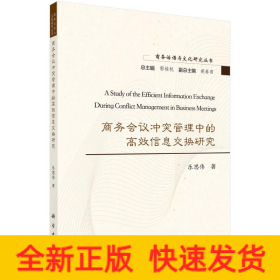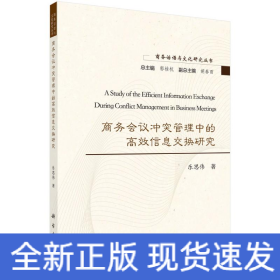
商务会议冲突管理中的高效信息交换研究
全新正版 极速发货
¥ 63.5 6.5折 ¥ 98 全新
库存3件
作者乐思伟 著
出版社科学出版社
ISBN9787030696700
出版时间2021-10
装帧平装
开本16开
定价98元
货号1202524281
上书时间2024-11-21
- 最新上架
商品详情
- 品相描述:全新
- 商品描述
-
作者简介
乐思伟,1984年生,湖北宜昌人。博士,广东外语外贸大学国际商务英语学院副教授。主要从事商务话语、商务文化及交际研究,在国内外公开发表学术论文20余篇,主持省级项目1项,参与省部级、市厅级项目多项。主要讲授“跨文化商务交际”、“研究方法”(本科生)、“商务英语文体学”(硕士生)等课程。
目录
总序
前言
List of Abbreviations
Chapter 1 Introduction
1.1 Conflict Management in Business Meetings
1.2 Cultural Contexts of Conflict Management in Business Meetings
1.3 Information Exchange of Conflict Management in Business Meetings
1.4 Summary
Chapter 2 The Characteristics of Cultural Contexts of Internal Business Meetings
2.1 Profile of Chinese and American Internal Business Meetings under Investigation
2.1.1 Simulated Internal Business Meetings
2.1.2 The Themes of Internal Business Meetings
2.1.3 The Conflict Discourse of Internal Business Meetings
2.2 Three-dimensional Cultural Context of Business Communication
2.2.1 National Culture
2.2.2 Business Culture
2.2.3 Personal Culture
2.3 Three-dimensional Cultural Context of Chinese and American Internal Business Meetings
2.3.1 The Impact of National Culture Context
2.3.2 The Impact of Business Culture Context
2.3.3 The Impact of Personal Culture Context
2.4 Summary
Chapter 3 Information Exchange Scheme of Business Meetings
3.1 Communicative Purposes
3.2 Communicative Strategies
3.3 Communicative Skills
3.4 Discourse Information Structure
3.5 The Working Scheme of Information Exchange
3.6 Summary
Chapter 4 Communicative Strategies of Conflict Management in Business Meetings and Their Informational Characteristics
4.1 Conflict Management Strategies of Persuading and Their Informational Characteristics
4.1.1 Strategies Serving the Persuading Purpose and Their Information Structure
4.1.2 Distributional Characteristics of Strategies Serving the Persuading Purpose
4.1.3 Informational Characteristics of Strategies Serving the Persuading Purpose
4.2 Conflict Management Strategies of Compelling and Their Informational Characteristics
4.2.1 Strategies Serving the Compelling Purpose and Their Information Structure
4.2.2 Distributional Characteristics of Strategies Serving the Compelling Purpose
4.2.3 Informational Characteristics of Strategies Serving the Compelling Purpose
4.3 Conflict Management Strategies of Avoiding and Their Informational Characteristics
4.3.1 Strategies Serving the Avoiding Purpose and Their Information Structure
4.3.2 Distributional Characteristics of Strategies Serving the Avoiding Purpose
4.3.3 Informational Characteristics of Strategies Serving the Avoiding Purpose
4.4 Conflict Management Strategies of Accommodating and Their Informational Characteristics
4.4.1 Strategies Serving the Accommodating Purpose and Their Information Structure
4.4.2 Distributional Characteristics of Strategies Serving the Accommodating Purpose
4.4.3 Informational Characteristics of Strategies Serving the Accommodating Purpose
4.5 Conflict Management Strategies of Ignoring and Their Informational Characteristics
4.5.1 Strategies Serving the Ignoring Purpose and Their Information Structure
4.5.2 Distributional Characteristics of Strategies Serving the Ignoring Purpose
4.5.3 Informational Characteristics of Strategies Serving the Ignoring Purpose
4.6 Conflict Management Strategies of Collaborating and Their Informational Characteristics
4.6.1 Strategies Serving the Collaborating Purpose and Their Information Structure
4.6.2 Distributional Characteristics of Strategies Serving the Collaborating Purpose
4.6.3 Informational Characteristics of Strategies Serving the Collaborating Purpose
4.7 Conflict Management Strategies of Bargaining and Their Informational Characteristics
4.7.1 Strategies Serving the Bargaining Purpose and Their Information Structure
4.7.2 Distributional Characteristics of Strategies Serving the Bargaining Purpose
4.7.3 Informational Characteristics of Strategies Serving the Bargaining Purpose
4.8 Conflict Management Strategies of Supporting and Their Informational Characteristics
4.8.1 Str
内容摘要
本研究以语篇信息理论为基础,研究商务会议中的冲突管理策略和技巧。通过对中美两个商业真人秀节目中商务会议内容的转写和对策略、技巧及语篇信息的标注,整理出商务会议中的冲突话语,进行了以自建小型语料库为基础的定性研究,通过语篇信息分析及统计分析,就商务会议冲突管理中的信息交换问题进行深入探讨。本研究构建了以国家文化、商业文化和个人文化为社会语境,由交际目的、交际策略、交际技巧、信息结构组成的四层等级模型的分析框架,识别了交际目的、交际策略、交际技巧的类型并考察了其如何通过信息交换得以表征。
本书适合从事商务话语研究、商务文化研究的研究人员和从事商务沟通实务和员工培训的从业人员阅读。
相关推荐
-

商务会议冲突管理中的高效信息交换研究
全新广州
¥ 63.50
-

商务会议冲突管理中的高效信息交换研究
全新广州
¥ 61.50
-

商务会议冲突管理中的高效信息交换研究
全新保定
¥ 60.76
-

商务会议冲突管理中的高效信息交换研究
全新保定
¥ 51.00
-

商务会议冲突管理中的高效信息交换研究
全新保定
¥ 55.20
-

商务会议冲突管理中的高效信息交换研究
全新广州
¥ 63.50
-

商务会议冲突管理中的高效信息交换研究
全新广州
¥ 61.50
-

商务会议冲突管理中的高效信息交换研究
全新保定
¥ 55.86
-

商务会议冲突管理中的高效信息交换研究
全新武汉
¥ 157.10
-

商务会议冲突管理中的高效信息交换研究
全新保定
¥ 55.20
— 没有更多了 —












以下为对购买帮助不大的评价